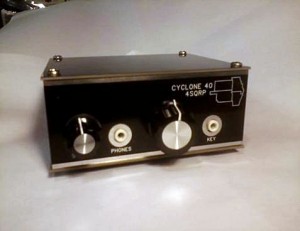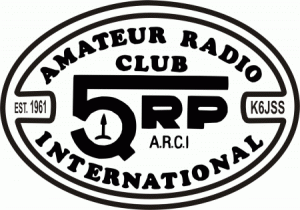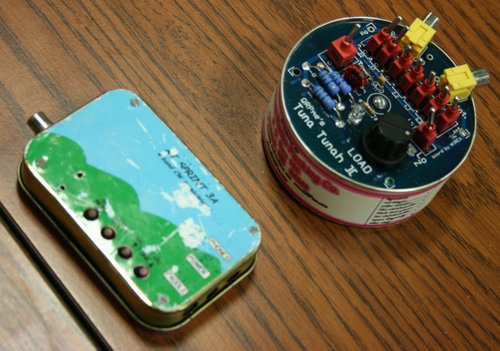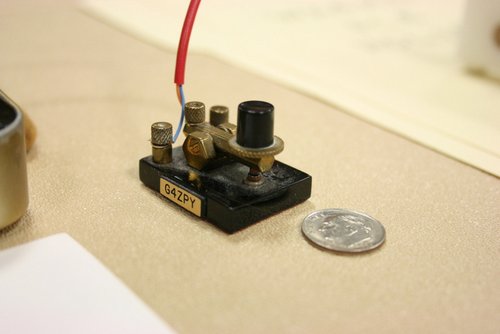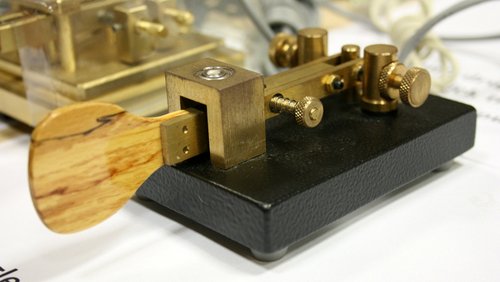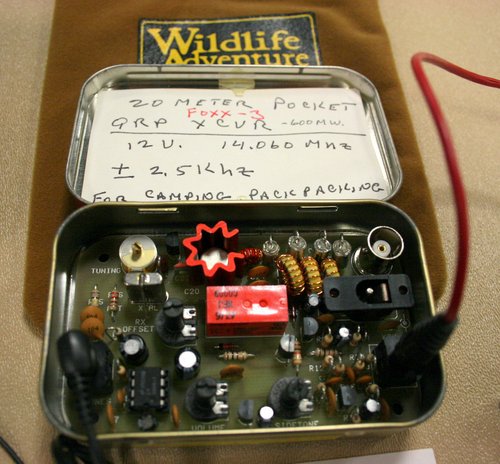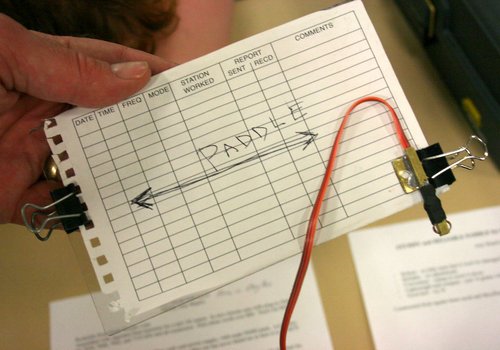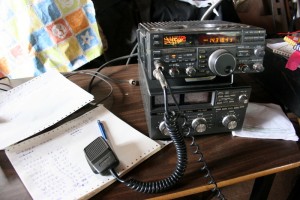Author Archive
 The Hallicrafters SX-88: a rare find and a gem of engineering
The Hallicrafters SX-88: a rare find and a gem of engineering
[Note: this post first appeared on my shortwave radio blog, the SWLing Post.]
Yesterday while glancing through the QTH.com classifieds ads, I noticed a rare boat anchor for sale: the Hallicrafters SX-88.
The seller, Jeremy, describes this SX-88 as follows:
Hi [t]here, I have one SX88 in minty shape and is one of a handful that came in military green on [the] front panel for evaluation by the military. This is an exceptional radio in amazing condition. I can provide pics for someone who is seriously interested. I am open to a fair offer on radio. Please, no low-ballers. We all know what [it’s] worth…
 “We all know what it’s worth“–?
“We all know what it’s worth“–?
Well, it just so happened that my good friend (and Elmer, or ham radio guru) Mike Hansgen (K8RAT) had recently provided me with a little history lesson on the subject of the SX-88, so I did know what this rig is worth: a great deal of money.
But curiosity got the best of me, so I contacted Jeremy (a nice fellow, by the way) and asked what he was expecting to receive in exchange for his Hallicrafters SX-88? Jeremy’s reply:
“…$5,500 USD will take it. It is a very rare unit; it was… only one of about 6 [painted green]…for presentation to the military for evaluation.
That price is firm. [I] will not negotiate downward, and shipping [from Ontario, Canada] is extra.”
After receiving this response from Jeremy, I happened to think that I have the reference guide to rare/used shortwave receivers: Fred Osterman’s Shortwave Receivers Past and Present 4th edition. (Click here for more info.)
Osterman’s wonderfully comprehensive guide mentions that the SX-88 is a “highly regarded, rare and collectible model.” As for the rarity of the SX-88, he describes it thus: “Extremely Scarce.” The used price range he gives is from $3,500-7,000 US.
I also have Chuck Dachis’ book, Radios By Hallicrafters; in it, he states that the SX-88 is, “the most sought-after Hallicrafters model.” Wow.
After thanking Jeremy for his response, he replied:
“It’s a lot of money for a receiver for certain, but it is a fantastic shortwave receiver as the audio that comes out of it is amazing.
It has 10 watts of audio and into a big speaker–it is second to none. The fidelity is amazing and it is the king of its kind. [For those who like] tube rigs, it is the best of its kind.
For ham purposes on AM it is amazing, and on CW I find it incredible to use.
[W]hen they built this thing they intended to pull all [the] stops out and build the best radio they could for the day with the military in mind. It was an engineering marvel for the day.
Anyway, I have played with it for years now and need to thin out the herd.”
Impressive. And while I just don’t have that kind of money to fork out for a receiver, I did ask myself the question: “If I had $5,500 to blow, would I get that Hallicrafters SX-88?”
And my answer? Yes. In fact, I would personally drive to Jeremy’s home in Ontario and bring it back; no way I’d trust it to a parcel carrier or the post office…
Come on, you may say. For a guy who rarely pays over $50 for a vintage receiver, how could you possibly justify that kind of financial and time commitment–?
Well, let’s think of it this way. I remember when when I paid well over two thousand for my first laptop in college. How much is it worth now? Maybe twenty dollars–?
Many people have retirement funds in investments, some of which are in a variety of innovative companies that they actually patronize–for example, Apple or Microsoft. But how often can you find an investment that you can actually play with? One which you can turn on, tune in, work the controls, and enjoy?
Yes, I’m sure this is just the sort of justification voiced by many a vintage car collector…So, why not for a museum-worthy radio? After all, they’re not making these anymore.
I expect this Halli will not only hold its value, but will probably increase in value over time.
Ah, well; fun to ponder. My question to you: Would you buy a $5,500 vintage receiver if you had it to spare?
If your answer is yes, and you do have the money, then you might want to contact Jeremy.
I’m very curious if there are any SX-88 owners among our readership? If so, please comment with your thoughts about the ’88!
And for the rest of us, just so we can revel in the vicarious pleasure of ownership, I’ve included some additional information about the Hallicrafters SX-88 below, including two videos.
Resources (courtesy of Jeremy):
[youtube http://www.youtube.com/watch?v=ozclVUwZ_mM]
[youtube http://www.youtube.com/watch?v=clF5HsewTnU]
 David Cripe’s NM0S Cyclone 40 Meter Transceiver kit
David Cripe’s NM0S Cyclone 40 Meter Transceiver kit
Readers, check out the Cyclone 40 in this release:
A new kit from the Four State QRP Group and David Cripe (NM0S)
Arising from Dave’s entry in QRP ARCI’s 72 Part Challenge Design Contest in 2010, the Cyclone 40 is an enhanced version of the original design. The transceiver designed for the design contest had 72 total parts, performed well, and won honorable mention. This improved version has less than 100 components and even better performance! The kit features all through hole parts and easy assembly. The receiver is a superhet design with very good sensitivity and selectivity, and tunes the entire 125 kHZ CW segment of the 40M Band – and does so at a comfortable tuning rate. A frequency readout is included so you know where you are at all times.
This is a complete kit, including the enclosure. A high quality board package includes the pc board, front and back panels, the sides, and top and bottom all of which make up the enclosure. The control and jack labels are silk screened in white letters and vividly contrast with the black solder mask, and the holes for the connectors and controls are pre-drilled. The ends are “dovetailed” together making a very rugged, easy to build, and attractive enclosure.
Features and Specifications
General
- Enclosure: A very nice predrilled and silkscreened enclosure is included. It’s easy to assemble and looks great.
- Ergonomics: Smooth solid tuning, a quiet receiver with QSK and well behaved AGC. Nicely laid out front and rear panels.
- VFO: The VFO is a simple PTO design, is very stable, and also quite easy to build
- Sidetone: Included!
- AGC: Audio derived, fast and smooth.
- Frequency Range: 7.000 – 7.125 typical.
- Tuning Speed: 10kHz/knob turn typical.
- Stability: 300 HZ the first 5 min after power up, less than 10 HZ/hour after that.
- QSK: Fantastic QSK! Full Break in, excellent muting, really fast!
- All Through Hole Parts There are NO SMT parts in this kit, and only three easy to wind toroids.
- Dimensions: 4.4 x 3.6 x 1.9″
- Power Connector: 2.5×5.5mm coaxial, center positive. Should be fused at 1A, fast blow at PS
- Antenna connector: BNC
Receiver
- Configuration: Superheterodyne, 11 MHZ IF, 4 Crystal IF Filter.
- Sensitivity: MDS (Minimum Discernable Signal) -125, Typical, below the normal 40M band noise level.
- Selectivity: Four crystal, 500 HZ IF filter
- IMD3: 90 dB typical, better than most commercial gear!
- IP3: +10 dBm typical – another very good number
- Frequency Readout: 3 or 4 digit CW, 1 kHz or 100 Hz resolution (user selectable), developed by Adrian Hill, KCØYOI.
- Band Edge Marker: A band edge marker is heard at 7.001 MHZ
- Headphone Jack: 1/8″ stereo, standard earbud/Walkman® headphone compatible
- DC Current consumption: 30 ma typical at 13.6 VDC.
Transmitter
- Configuration: Stable, Wide Range VFO (PTO design), Efficient Class E Final.
- Spectral Purity: All harmonics and spurs less than 50dB below the carrier.
- Output Power: approximately 4W into 50 ohms
- DC Current consumption: 500ma typical at 13.6 VDC Will operate down to 9v DC.
- Key Jack: 1/8″ stereo, grounded shell, switching the tip keys TX. Contacts accessible for an internal add-on keyer
Kits should be available at QRP ARCI’s Four Days in May conference at Dayton, and will be for sale on the Four State QRP Group’s web site approximately May 20th. The final price hasn’t been determined yet but should be less than $100 plus shipping.
 Four Days In May: A look back at FDIM 2012…
Four Days In May: A look back at FDIM 2012…
One of the highlights of my trip to the Dayton Hamvention last year was attending evenings at Four Days in May (FDIM), a QRP convention sponsored by the QRP ARCI that rather conveniently coincides with the Dayton Hamvention, which I try to attend annually. Though scheduling makes it difficult for me to attend all of FDIM’s daytime presentations, the camaraderie and innovation one discovers at the evening sessions is wholeheartedly worthwhile.
Last year, I snapped quite a few photos at FDIM which I planned to post following the Hamvention. Unfortunately, shortly after the Hamvention, my laptop began displaying signs of an early demise. In haste, I archived my photos on a portable drive, where they remained buried for a year. I just rediscovered this photographic treasure, and thought I’d share it with readers; looking through them rekindled my enthusiasm for FDIM 2013, which starts next week!
A quick look at FDIM 2012
A great characteristic about FDIM is the array of QRP products offered by QRPers for the community. More often than not, these products are fairly priced, and often in support of the QRP community rather than major profit-making ventures.
For example, the North Georgia QRP Club produces affordable wood stands for QRP rigs. They’re incredibly simple, but fully finished and beautifully designed, just the thing to prop up your QRP portable at the right angle for desktop use.
These wooden stands support the following rigs:
- Elecraft K1, KX1
- Ten Ten R4020/R4030/R4040
- Yaesu FT817/FT817N
- Hendricks PFR3
The club can even accommodate custom orders for other rigs. Check out and purchase these on the NOGAQRP website.
Speaking of wood products–one vendor last year featured an amazing array of wooden paddle pieces and even custom wooden tuning dimples (spinner knobs) for the Elecraft K2 and K1.
As you can see from the photos, each piece is perfectly finished and has great character, as one might expect of real wood.
I also ran into Dennis Blanchard (K1YPP) and his wife, Jane, who were signing and selling their books. I wrote a review here on QRPer about Dennis’ story of the challenges and joys of through-hiking the Appalachian Trail. If you haven’t read Three Hundred Zeroes: Lessons of the Heart on the Appalachian Trail, you’re in for a treat. I’m hoping Dennis will attend FDIM this year.
Dennis, being a hard-core QRPer, trekked with ham gear in tow; he brought his kits to FDIM:
There were a variety of keys and paddles to be seen, of course; offerings range from the home brewed to gorgeous Italian Begali designs:
One paddle that really caught my attention was QuadraBug, a creation of WB9LPU. What makes this gem stand apart from other “Bugs” is that not only will it form “dits” automatically, but it also forms “dahs.” Truly, an amazing work of engineering. I searched the web for a video of the QuadraBug in action, but found nothing. [UPDATE: Thanks, Yan for finding a video! See video below.] This year, I’ll take a video if I’m fortunate enough to see it again.
Home-brew galore
There were an amazing number of home-brewed projects on display, and even a home-brew contest. I didn’t capture photos of them all, but I did manage to snap a few.
One that really caught my eye (being a shortwave receiver enthusiast) was David Cripe’s (NM0S) version of Hutch’s Radio. The original Hutch’s Radios were built by US and British POW’s in WWII. Built in canteens, often from confiscated parts, these radios gave POWs hope by allowing them to tune in the outside world, via the BBC WS and Voice of America. In the spirit of the original, David challenged himself to build his version prior to FDIM, with original parts of the era, and in “secrecy.” Secrecy? As many of the components had to be purchased from suppliers on eBay, David tried to intercept all of the incoming packages without his wife noticing. His success was brief–alas, his wife discovered the mission–but fun; still, the end result was a very cool piece of historical recreation with a humorous story to match:
Of course, FDIM featured loads of QRP transmitters, receivers and transceivers; here is Dwayne’s (AK4P) 40 meter transceiver, built in a SPAM container:
Terry Young, K4KJP, built a very cool pocket 20 meter transceiver in an Altoids tin:
And Alan Shapiro, NM5S, should have won a prize for the most compact set of CW paddles. These paddles are so small that they can be clamped onto your log book. Much to my surprise, they were amazingly easy to use, and would be a great addition to any field-portable radio:
FDIM 2013
If FDIM 2012 is any indication (yes), this is a mere sampling of the stuff you’ll see at Four Days In May 2013. I encourage you to attend: if nothing else, make a little time either Thursday, Friday or Saturday evening to visit the evening displays at FDIM–they’re free and open to the public.
If you can’t attend, I hope you’ll earmark your calendar for a future date. I do plan to bring my camera again this year and will share some photos. Hopefully, I’ll post them a little earlier this go-around!
Hope to see you at FDIM and the Hamvention. For the third year in a row, I will be representing my charity, Ears To Our World (ETOW), at an inside exhibit at the Hamvention. We should be in booth 601 in the East Hall. Please feel free to stop by and introduce yourself! (And if you feel so inclined, you can even donate a few bucks to our worthy cause.) See you there–!
Best & 72,
Thomas, K4SWL
 Harold’s JA7HJ tower was not your average tower
Harold’s JA7HJ tower was not your average tower
I meet some very interesting people in radio circles. My friend Harold Johnson (W4ZCB) is undoubtedly one of them.
Last year at my local ham radio/DXer club meeting, members were asked to bring photos of shacks and rigs, and describe our evolution as ham radio operators. In the series of photos that arrived at the following meeting, one in particular stood out: Harold Johnson’s radio tower in post-war Japan.
Johnson’s tower stood almost thirty feet tall and supported a 20 meter Yagi which you can see in the above photo. Johnson, who at the time operated under the callsign JA7HJ, also had a little ham shack built. The shack materials–including the tower, Johnson recalls–cost him “three bottles of Scotch for the army quartermaster…I paid the Japanese builder $15 or $20 for the complete enchilada.” This tower was built entirely of wood: the vertical members were 2′ x 4’s, the slats were 1′ x 3’s.
Of course, the tower didn’t have a mechanical rotor; instead, Johnson climbed inside the tower, lifted the wooden boom, rotated it manually, and placed it back on the uprights.
When asked how he powered his station, Johnson pointed to the wheeled generator in front of the radio shack in the photo. “The generator was called a B6B–it produced 24, 120, 240, and 480 volts, and was rated 10 kW.” When I asked how he managed to procure the generator, he replied that he “borrowed it from the flight line, which was about 300 feet away.”
I always enjoy hearing personal histories in radio and I didn’t doubt for a moment that Harold Johnson’s would be intriguing, so I asked if he’d tell us how his interest in radio began. So, here’s Johnson’s story in his own words:
As a preteen, (and poor as a church mouse during our previous
Depression), I would visit my aunt and uncle in the summer, likely due to the fact that they were farmers and had food to eat. They owned an old Philco radio that had shortwave bands and I was intrigued with the phone amateurs on the 80 and 20 meter bands. Often, I could hear both sides of the conversation, after I found out that they were on various different frequencies, being crystal controlled back then! My…How times have changed.In high school, I found another afficianado, and can recall melting “Woods metal” in boiling water and floating a piece of Galena on it until it returned to a solid and [thus] made my own crystal set. WWII had started by then, and I would listen to the ground-to-air communications between ships in Lake Michigan and pilots taking off and landing on them. Great DX, perhaps 10 miles away.
In 1943, I had graduated from high school and joined the US Army Air Corps. Went through training and was still in training (…to be a pilot until they counted airplanes and pilots and decided they had enough of each […so instead] turned me into a B-29 gunner). The war was over whilst [I was] still in training and I “retired” in November 1945. Went home and found my high school sweetheart, married, went back to school to finish my education and started the Johnson family. Still married, and
to the same girl. What a sweetheart to have put up with me all these years. [No kidding, Harold!]Went back in the US Air Force in 1949, this time became a pilot, and just in time to go to Korea for a year. However, during training, had to learn the Morse and if you learned to 13 WPM, you had a free hour and didn’t have to attend class. That overcame my obstacle to amateur radio, and I took the exams in 1950 and became W9PJO. Our rules at that time were that you had to hold a “class B” ticket for a year before you could take the “class A” exams. That year I spent in Korea and Japan and managed to obtain my first foreign call, JA7HJ.
Returning home to wife and by that time two children, I took the class A exams and became W4ZCB. I decided that I enjoyed flying, (at least most of the time), and decided to make it a career. The ensuing years, I was always on and in the air, and usually spent the winters in Alaska and the summers in the Canal Zone, anything to practice how to be miserable. Lebanon in 1958, Vietnam in 1968 and by 1969 decided that I should start doing something else before my luck ran out.
During my last 4 years of service I flew an Army four star around the world four times. Fortunately he was Ted Conway, W4EII, and we mutually enjoyed operating under a couple dozen different call signs from a lot of exotic (and several not so exotic) places. Had G5AHB back when the 5 was reserved for foreign nationals. We were good friends after we both retired (on the same day; I always liked to say that he couldn’t stand to serve without me) until his death in 1990.
I started a small company manufacturing electronic test equipment for public utilities; spent the next 20 years doing that (and enjoying a much more stable life with family and radio.) Managed to work all the countries (entities these days) there are, win a few contests from a contest station I built and operated for 10 years. (80, 40, and 20 in the front room, 15 in one bedroom and since 160 and 10 were seldom open at the same time, they shared the other bedroom. To change bands, you just changed chairs. Five big towers and Yagis, a VERY high maintenance hobby in the lightning prone state of Florida. (Let’s not mention hurricanes!)
Retired again to the beautiful mountains of North Carolina in 1986. A much more modest station these days, but active on all the HF bands. I really enjoy building homebrew radios and maintaining daily schedules with friends worldwide. Can be found daily on 21.203 with G3XJP and often joined by other builders of the magnificent PicaStar transceiver designed by him. Sixty-three years a ham, still enjoying it. It’s guided my careers and interests. What a wonderful hobby!
Over the past few years, I’ve gotten to know Harold Johnson; I must say, he has to be one of the very few hams I know who knows the inner workings of tube/valve radios as well as he does the highest tech radios on the market, a rare talent indeed. If you’re trying to learn a bit more about the BC-348 series of radios and trying to diagnose a problem with it, Johnson’s your guy. If you’re trying to build an SDR from scratch, he’s also your guy. And clearly, if you want to hear a fascinating account of a life influenced by radio, this is most definitely your guy.
Thanks, Harold, for letting me share your story!
Check out Harold Johnson’s website by clicking here.
 Author interview: Dennis Blanchard’s (K1YPP) “Three Hundred Zeroes: Lessons of the Heart on the Appalachian Trail”
Author interview: Dennis Blanchard’s (K1YPP) “Three Hundred Zeroes: Lessons of the Heart on the Appalachian Trail”
This year, at the Four Days in May (FDiM) Dayton QRP gathering, I had the pleasure of meeting Dennis Blanchard (K1YPP) and his wife, Jane, as Blanchard signed copies of his book, Three Hundred Zeroes: Lessons of the Heart on the Appalachian Trail. I had previously heard about Blanchard’s book, and it was great meeting the author in person. Both he and his wife were most friendly, and I instantly felt a connection–after all, he is a fellow QRPer!
As a result of this meeting, I recently decided to purchased a copy of Three Hundred Zeroes on my Kindle eBook reader. Though I’ve always been a fan of turning pages on a traditional book, the eReader does afford one instant gratification, as you can order it on-the-go and start reading immediately. And that’s exactly what I did…
The result? I’m very glad I took the time to read Blanchard’s Three Hundred Zeros. Though I don’t like to spend much time away from my young family at present, I’ve always thought it would be a wonderful challenge and adventure to through-hike the AT (Appalachian Trail); reading this book was a vicarious opportunity to do so. Indeed, my favorite trail, the BT–the Bartram Trail, which follows the path of early American naturalist and explorer William Bartram–which I hike when I can, and whose NC chapter I’ve served as a board member for nearly 10 years now, parallels the AT at different points. So the temptation to hike (and QRP, of course) continues.
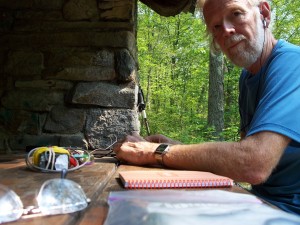
“This photo was taken in NJ. Shortly after I took these photos, and walked down the trail about a 100 feet, a bear came over to check the table to see if I had left anything.” (Photo: K1YPP)
Blanchard’s book gives me hope. Three Hundred Zeroes is a well-documented, informative, and–despite his truly serious heart condition–often humorous journal-style account of his successful thru-hike of this 2176 mile trail. His writing style is very informal and likeable, focusing on the many personal interactions that make the trail hiker’s experience unique, and interweaving his day-to-day accounts with trail lore and history.
In contrast with the arduous journey Bill Bryson describes his well-known (and hilarious) book, A Walk in the Woods, in Three Hundred Zeros Blanchard calmly and routinely deals with misadventures and hair-raising encounters with wildlife, rolling with the punches and somehow emerging unscathed. He describes the journey as “long stretches of boredom, punctuated by brief moments of excitement” in the lively and unpredictable form of bears, mice, snakes, and even other hikers, to some degree. Blanchard was obviously a great hiking companion, thus rarely hiked alone–no doubt, other hikers sought his company.
With QRP in mind, I had a few questions for Blanchard after reading his book. He has kindly taken the time to respond to QRPer.com‘s questions, as follows.
QRPer: I always thought that the AT would be a lonely place, but your book certainly changed my mind. Were there many stretches of trail where you were completely alone while trekking or camping at night?
Blanchard: There were times when I was alone for extended periods. However, “alone” is a relative term. Throughout the day I would encounter other hikers going in the other direction, or people that were slower or faster than I. In 180 days on the trail, I think I had three nights when I camped alone.

“2007-Damascus, VA was where I operated Field Day in 2007. It was shortly after this that I left the trail for the heart surgery.” (Photo: K1YPP)
QRPer: What was your favorite stretch of trail?
Blanchard: That’s difficult to answer…The trail is so varied and weather can change one’s views of any section. For me, it was a coin toss between the New Hampshire White Mountains and the 100 Mile Wilderness in Maine. The remoteness of both areas was just so spectacular. Of course the high altitudes made for great antenna opportunities as well.
QRPer: Did you bring a radio to listen to local AM/FM or shortwave?
Blanchard: For most of the hike, I carried a Yaesu VX-1R 2/440 handi-talkie. I think I used it about three times on two-meters. In a few situations, such as up in the White Mountains, I used the VX-1R to tune in NOAA for weather news. It also has AM/FM and on a few very rare occasions, I tuned into local stations for news. Would I carry it again? I don’t know. It is wise to have something for emergencies, and the radio wasn’t too big or heavy, but it was extra weight.
QRPer: Specifically, what ham gear did you take with you? Do you have a photo?
Blanchard:As noted in the book, I did carry a home-brewed 80/40 meter CW rig for the first 600 miles. For the rest of the hike I carried Steve Weber’s ATS-3A. The radio was powered by six Energizer disposable lithiums, in a home-brewed battery pack. The pack could also charge my cell phone and power the 2-meter VX-1R radio. I used a 51 foot random wire for the antenna and some counterpoise wire, usually about 15 feet. Altogether, the gear weighed around two pounds.
QRPer: If you were to do the hike again, would you take the same equipment?
Blanchard: I’m not certain I would carry the VX-1R again. I didn’t use it much and it is extra weight. However, the NOAA weather, and 2-meter capability could prove extremely useful in an emergency.
QRPer:What was it like coming back off the trail once you completed it? Any especially notable things about how you perceived the world around you? Did it change you? Any culture shock?
Blanchard: The only real “culture shock” was riding in automobiles. Everything seemed to move so quickly. I much more enjoy walking and biking now. I would be happy if I never had to drive again.

“KD2VX, Kathy, was the trail angel that helped out with my hike up in New Hampshire. She is a QRP fan.” (Photo: K1YPP)
QRPer: How many other hams did you meet on the AT who were either through-hiking the AT, or hiking sections?
Blanchard: Since we [hikers] don’t wear being a “ham” on our sleeve[s], I can’t really say how many hams I encountered. The few that I was aware of were mostly section hiking. One benefit of setting up my QRP station along the way was public visibility for ham radio. On a number of occasions I inspired my fellow hikers to look into ham radio when they returned home. I’ve even had a few readers of the book write me to tell me they went off and got a ham license based on inspiration from the book.
QRPer: If any other QRPers are inspired by your story, and are thinking about hiking the entire AT, how much money should they budget for such an adventure? Based on what I read, there are a number of budgetary considerations for shuttles, food, gear, and the like.

“Duncannon, PA was were I operated Field Day. The station table was a few rocks I moved around.” (Photo: K1YPP)
Blanchard: The answer to this question depends on how many “creature comforts” one wishes. Hiking as I did, with stops along the way about every 5-10 days, can cost about $1-$3 a mile. Those on a tight budget could do it for much less, and those that enjoy getting to hotels and eating in fancier places could spend more. Most of the shuttles were really not that expensive, at least those that cater specifically to hikers. The hostels are a real bargain, compared to standard hotels, but one may have to tolerate annoyances, such as snoring and people coming and going at unusual hours. If you’re a light sleeper, this could be an issue.
QRPer: On zero days [based on your descriptions] it seems like hikers simply stuff themselves with food. I’m really curious what you typically ate on the trail?
Blanchard:The short answer is: I ate everything. I’m not fussy, and don’t have any diet limitations. If someone is diabetic, or vegetarian, it is still possible to undertake such a hike, it just might require more preparation. My typical day was a few Pop Tarts first thing in the morning, or hot oatmeal on cold days, followed by an on-trail mid-morning snack, such as a Snickers Bars or trail mix.
Lunch was usually something that didn’t need cooking. Roll-up tortillas, or bagels with peanut butter won out most of the time. In the colder weather, bagels and cream cheese was a favorite. Gatorade powder mix, or hot chocolate in cold weather, was my favorite drink for lunch.
The evening meal was usually a pasta-based affair, or couscous. I really preferred the couscous; it is very light to carry, needs very little energy to cook, and is loaded with nutrients. I would usually stir in some dried vegetables with it, or dried meat. As a side I would carry a dried sausage, such as pepperoni, which could also serve as a snack for lunch. I usually carried some desert items as well, such as cookies or dried fruit. Of course energy bars would supplement all of this along the way. Many hikers preferred candy bars, but I tried to avoid them in the warmer weather since they melt.
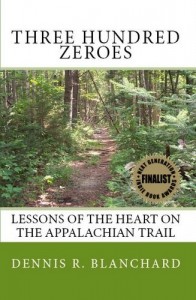 Overall, even though the diet sounds bland, it wasn’t bad. Of course, whenever we hit a town, I would stuff on everything in sight. I actually did eat well, but couldn’t find enough calories to maintain my weight. I ended up losing 35 pounds at the end of the hike and looked like a refugee.
Overall, even though the diet sounds bland, it wasn’t bad. Of course, whenever we hit a town, I would stuff on everything in sight. I actually did eat well, but couldn’t find enough calories to maintain my weight. I ended up losing 35 pounds at the end of the hike and looked like a refugee.
Well, Dennis–all I can say is that I hope you’ve gained back some of those lost pounds, continue to be in good heart-health, and are able to enjoy a little QRP on your forthcoming hikes. Thanks very much for taking the time to answer our questions; we wish you the very best!
You can purchase Dennis’ book from Amazon.com or Barnes and Noble and visit his website at threehundredzeroes.com.
 Field Day on Holiday
Field Day on Holiday
As I mentioned in a previous post, I’ve been on vacation in Prince Edward Island Canada.
This year, our vacation coincided with my favorite annual event, Field Day.
Sadly, I missed an opportunity to experience Field Day QRP-style with the NC-based QRP club, the Knightlites, on the Blue Ridge Parkway, along with my buddy, Vlado (N3CZ).
Before I left my trip up north, I contacted the Charlottetown, PEI, Amateur Radio Club (VY2CRS) and was glad to learn that they had planned a Field Day event on the farm of their club President, Andy Speelman (VA2AS). Better yet, the location was just forty minutes from the cabin where we were staying on PEI.
Perhaps one of the benefits we enjoy as amateur radio operators is that we’re all part of one enormous event, an all-inclusive fraternity of like-minded individuals. When I arrived on site at the Charlottetown Field Day location, I was greeted as if I was expected. The large sign at the end of Andy’s driveway was a great advertisement for the FD location.
They instantly put me to work…eating a hamburger. After all, you can’t work a radio rig without a little something in your fuel tank, right?
“Islander” hospitality is legendary, and frankly, reminds me of the way it was when I was growing up in rural North Carolina where “no one’s a stranger,” and you’re free to accept invitations (and meals) without hesitation. This local club went a step further, and from the moment I arrived, included me in their jokes, making sure to laugh not just at but with me. I felt utterly at home.
 The club had a wide array of antennas up by the time I arrived. All of them had been constructed just prior to the beginning of the contest, and all were field-deployable. Andy’s farm is a wide-open space and with no limitations to big antlers, thus they even fit a 160M “V” doublet out in front of the barn where we operated.
The club had a wide array of antennas up by the time I arrived. All of them had been constructed just prior to the beginning of the contest, and all were field-deployable. Andy’s farm is a wide-open space and with no limitations to big antlers, thus they even fit a 160M “V” doublet out in front of the barn where we operated.
Though I had only a few hours to play radio before heading back to my family at the cabin, they put me on the 20M almost immediately. In perhaps an hour, I chalked up 100+ contacts on that band. The guys got a kick out of hearing me call “CQ Field Day, CQ Field Day, this is VY2CSR” and then offering up our “3 Alpha Maritime” in my North Carolina accent.
It was also fun to get a quick word in with those NC stations I worked from the island, many of whom were set up only a few miles from my home QTH.
I made sure I saved plenty of time for chatting with the club members, too. After all, this Field Day event– like many others I’ve attended–was more about comraderie and fun rather than about raking in the scores and multipliers (not that taking it to a contest level is objectionable, of course).
Fellows in Charlottetown: if you’re reading this post, I surely thank you for including me in FD 2012, Charlottetown-style.
Readers, if you happen to be on vacation during Field Day, search for a local event. There’s sure to be one and you’ll most likely make some new friends and create some notable radio memories.
 A QRP Family Holiday on Prince Edward Island, Canada
A QRP Family Holiday on Prince Edward Island, Canada
This year, during our family’s summer holiday, I’m enjoying the hospitality of Prince Edward Island, Canada (hence, the lack of recent posts). This is our family’s second visit to the maritime island, and each time we’ve been fortunate to stay at the same off-the-grid cabin on the eastern coast, less than twenty meters from the water.
Of course, staying in an off-grid cabin comes with its radio challenges—namely, supplying power—but also comes with one supreme advantage: no noise from the typical electrical devices that plague most of our homes. What’s more, this cabin sits on 60 acres, so not even a neighbor’s home appliances disturb my RX ears.
On our previous visit, I brought my (then) Yaesu FT-817, a 9aH gel cell, Micro M+ charge controller, 10W Solarex PV panel, some 300 ohm window line, loads of 22 AWG wire and an LDG ATU. Unfortunately, I found I had very little time for radio, and propagation was dismal. Indeed, it was during that trip that I discovered my FT-817’s finals had blown, so part of the time I was transmitting less than QRPpppp levels.
This year, since I knew the site well, I came better prepared.
My full 2012 setup consists of the following:
- An Elecraft K2/10
- An Elecraft KX1 (4 band w/built-in ATU)
- Elecraft T1 ATU
- LDG 4:1 Balun
- One 35 aH gel cell
- Two 9.5 aH gel cells
- Two PowerFilm Solar foldable 5 W PV panels
- My radio toolbox with various connectors, crimpers, cutters, wires, caps, multi-tester, etc.
- Enough wire and 300 ohm antenna line to make a couple of wire antennas
So…how’s it all working out? Brilliantly!
In the past few years I’ve done a lot of QRP CW—mainly rag-chews with some buddies on the lower bands. I’ve done less QRP SSB phone. When I first arrived at the cabin and began the process of unpacking, I couldn’t find the jumper cable to attach to my Vibroplex single-lever paddle (the paddle being a Dayton 2012 find, by the way). So, I plugged in a microphone and tuned to the phone portion of the 17 meter band.
Talk about radio fun!
I’ve once again re-discovered the joy of operating QRP SSB. It’s challenging to make those DX contacts and to transmit a long call sign (“VY2 portable K4SWL”) across the ether, but occasionally the propagation gods smile upon you, and you’re able to participate in a good rag-chew or quick DX with a 57 to 59 signal report.
Being 20 meters from the salt water is a bonus I don’t usually enjoy in my US hermitage. Due to its excellent propagation characteristics, despite my lower power set-up, I have easily worked stations from Russia to North Africa, from the Caribbean to Japan. I am thoroughly reveling in it, and the process has re-connected me with my ham radio roots.
As Gunter, VA3GA, told me in a recent Canadian rag-chew, “ham radio holidays give you a chance to explore areas of the hobby you don’t normally think to enjoy.”
So true, Gunter. That’s what I love about ham radio in general– the hobby is so broad, you constantly discover and re-discover favorite elements about it.


